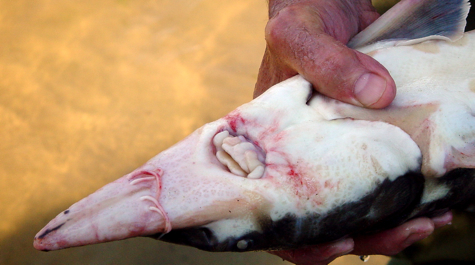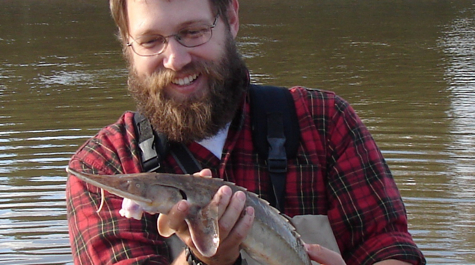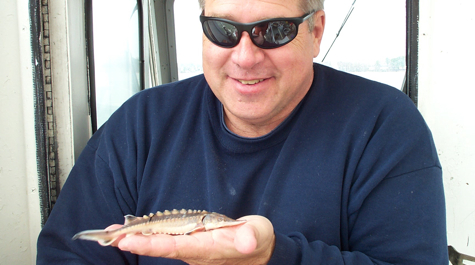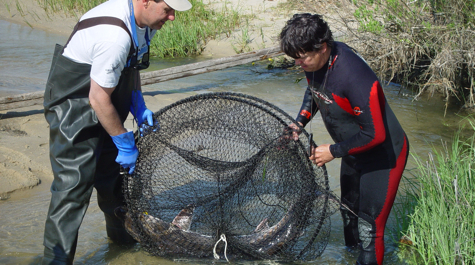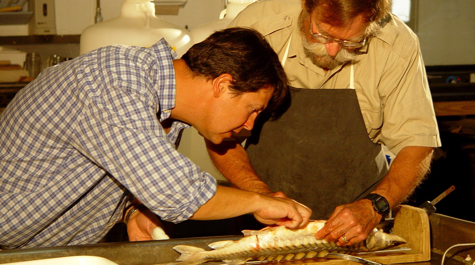VIMS research lays foundation for sturgeon restoration
Decades of work by researchers at the Virginia Institute of Marine Science has laid the foundation for a recent milestone in efforts to restore Atlantic sturgeon to the James River—a plan led by the James River Association in partnership with Virginia Commonwealth University and Luck Stone to construct a spawning reef for these ancient fishes in the waters below Richmond.
The reef project—just given the green light by the Virginia Marine Resources Commission—will use a $50,000 grant from the National Fish and Wildlife Foundation to build an artificial spawning reef at the Turkey Island Cutoff, near the Presquile National Wildlife Refuge in Chesterfield County. When complete, the 70' X 300' structure will reach 2 feet above the muddy river bottom, hopefully giving female sturgeon the type of clean, hard surface they prefer for laying their eggs.
VIMS research suggests that silting over of historically available hard-bottom spawning grounds is a major roadblock to restoration of sturgeon populations in Chesapeake Bay, as is the sturgeon's slow reproductive rate.
The Bay's population of Atlantic sturgeon has yet to recover from a drastic decline caused by overfishing in the 1880s and 1890s. Numbers of Atlantic sturgeon are now so low that the National Marine Fisheries Service is considering listing the fish as threatened. A coast-wide moratorium on sturgeon harvesting was enacted by the Atlantic States Marine Fisheries Commission (ASMFC) in 1998. Virginia has banned sturgeon harvesting since 1974.
Sturgeon research at VIMS, led by Drs. Chris Hager, Jack Musick, and Eric Hilton, has been instrumental in determining the reef's design and location. The reef is scheduled for completion this spring, just in time for the sturgeon spawning migration. Like salmon, Atlantic sturgeon are anadromous fishes that live in the ocean but spawn in freshwater.
Hager, a Fisheries Bycatch Specialist with the Sea Grant Marine Advisory Program at VIMS, began his sturgeon research in 2005 by partnering with local fishermen. They used acoustic tracking technology in cooperation with the Army Corp of Engineers' Engineer Research and Development Center to throw light on sturgeon abundance, habitat use, behavior, and seasonal movements within local waterways. The study was funded by a Fisheries Resource Grant from the Virginia Sea Grant Program.
Hager has continued and expanded these behavior studies into efforts to develop conservation gear to reduce sturgeon bycatch. This effort is in partnership with Matt Balazik, a graduate student at Virginia Commonwealth University, Chuck Frederickson of the James River Association, and Albert Spells of the US Fish and Wildlife Service.
Musick, now an emeritus professor, has conducted sturgeon research since the 1970s. Most recently, he partnered with Dr. Hager, VIMS technician Tara Bushnoe, and Dr. Donna Bilkovic in VIMS' Center for Coastal Resources Management to locate and map benthic habitats that sturgeon prefer for their spawning and nursery grounds. Because many of these beds are now buried by silt, their efforts required use of side-scan sonar to peer beneath the seafloor. This effort was funded largely by the U.S. Fish and Wildlife Service and the NOAA Chesapeake Bay Office.
Hilton, an expert in sturgeon classification who joined the VIMS faculty in 2007, provides the broad expertise of sturgeon biology that is needed to help identify unique aspects of East Coast Atlantic sturgeon stocks. The morphological, genetic, and behavioral structure of Atlantic sturgeon, and sturgeon species generally, are unclear and hotly debated. Atlantic sturgeon are highly migratory, and this type of information is key to ongoing efforts for sturgeon restoration.
The on-going effort to restore Chesapeake Bay's sturgeon population involves numerous other partners, including the Maryland Department of Natural Resources, the Horn Point Laboratory at the University of Maryland's Center for Environmental Science, and the Virginia Dept. of Game and Inland Fisheries.
Because Atlantic sturgeon are distributed along virtually all of the East Coast and individuals are highly migratory, the restoration effort is coordinated by the multi-state ASMFC.


